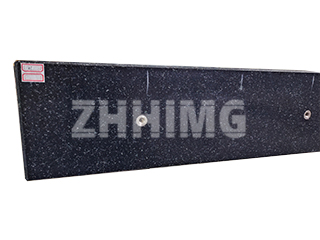When commissioning a granite precision platform for high-stakes metrology or assembly, clients frequently ask: can we customize the surface with markings—such as coordinate lines, grid patterns, or specific reference points? The answer, from an ultra-precision manufacturer like ZHHIMG®, is a definitive yes, but the implementation of these markings is a subtle art that requires expertise to ensure the markings enhance, rather than compromise, the platform’s core accuracy.
The Purpose of Precision Surface Markings
For most standard granite surface plates or machine bases, the primary goal is achieving the highest possible flatness and geometric stability. However, for applications like large-scale assembly jigs, calibration stations, or manual inspection setups, visual and physical aids are necessary. Surface markings serve several critical functions:
- Alignment Guides: Providing quick, visual reference lines for rough positioning of fixtures or parts before engaging micro-adjustment stages.
- Coordinate Systems: Establishing a clear, initial coordinate grid (e.g., X-Y axes) traceable to the center point or edge datum.
- No-Go Zones: Marking areas where equipment should not be placed to maintain balance or prevent interference with integrated systems.
The Accuracy Challenge: Marking Without Damaging
The inherent difficulty lies in the fact that any process used to apply markings—etching, painting, or machining—must not disturb the sub-micron or nanometer flatness already achieved by the rigorous lapping and calibration process.
Traditional methods, like deep etching or scribing, can introduce localized stress or surface distortion, compromising the very precision the granite is designed to deliver. Therefore, the specialized process employed by ZHHIMG® utilizes methods engineered to minimize impact:
- Shallow Etching/Engraving: The markings are typically applied through precise, shallow engraving—often less than ±0.1 mm deep. This depth is critical because it allows the line to be visible and tactile without significantly reducing the granite’s structural stability or distorting the overall flatness.
- Specialized Fillers: The engraved lines are usually filled with a contrasting, low-viscosity epoxy or paint. This filler is engineered to cure flush with the granite surface, preventing the marking itself from becoming a high point that would interfere with subsequent measurements or contact surfaces.
Accuracy of the Markings vs. Platform Flatness
It is essential for engineers to understand the distinction between the accuracy of the platform’s flatness and the accuracy of the markings’ placement:
- Platform Flatness (Geometric Accuracy): This is the ultimate measurement of how perfectly planar the surface is, often guaranteed to the sub-micron level, validated by laser interferometers. This is the core reference standard.
- Marking Accuracy (Positional Accuracy): This refers to how accurately a specific line or grid point is placed relative to the platform’s datum edges or center point. Due to the inherent width of the line itself (which is often around ±0.2mm to be visible) and the manufacturing process, the positional accuracy of the markings is typically guaranteed to a tolerance of ± 0.1 mm to ± 0.2 mm.
While this positional accuracy may seem loose compared to the nanometer flatness of the granite itself, the markings are intended for visual reference and setup, not for the final precision measurement. The granite surface itself remains the primary, immutable precision reference, and the final measurement should always be taken using metrology tools referencing the platform’s certified flat plane.
In conclusion, custom surface markings on a granite platform are a valuable feature for enhancing workflow and setup, and they can be executed without compromising the platform’s high-precision performance. However, they must be specified and applied by an expert manufacturer, ensuring the marking process respects the fundamental integrity of the ultra-high-density granite foundation.
Post time: Oct-21-2025

